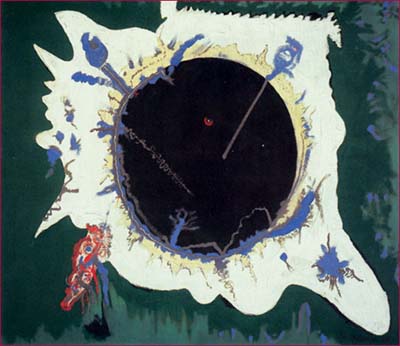 "Pagan Void", 1946 National Gallery of Art, Washington, Gift of Annalee Newman, in Honor of the 50th Anniversary of the National Gallery of Art 1988.57.1 © ARS, NY and DACS, London 2002 Barnett Newman Newman's paintings are impossible to grasp from reproductions. They require us to stand before them, close enough to experience all their nuances of colour and structure. So adamant was Newman about the way his art should be viewed that he once typed a statement and stuck it to the gallery wall instructing people to stand at only a "short distance" from his canvases. Seen in proximity, Newman believed that his work could engender feelings of heightened self-awareness. "I hope that my painting has the impact of giving someone, as it did me, the feeling of his own totality, of his own separateness, of his own individuality," he said. Though Newman always insisted on the rich emotional content of his work, for most of his life it met with incomprehension and charges of "emptiness". He kept nothing he made before he was nearly forty years old, and over the rest of his career produced only around 120 paintings. It was not until he was nearly sixty that he began to be recognised as one of America's foremost artists. Born in 1905 in New York, the son of Polish-Jewish immigrants, Newman grew up in the Bronx, and in his early career was known as a critic rather than a painter. Politically committed, he counted himself an anarchist, and in 1933 offered himself as a candidate for mayor of New York City with a manifesto calling for "action by men of culture". He came of age as an artist after the Second World War, when, together with contemporaries such as Jackson Pollock, Mark Rothko, Adolph Gottlieb and Clyfford Still, he developed a new style of painting, Abstract Expressionism. The intervening years have seen Newman variously described as an exemplar of high modernism, a practitioner of the art of the sublime, a precursor of Minimalism, an existentialist, and a spiritual artist fascinated by Jewish mysticism. For his own part, he declared in 1947, just as he arrived at his mature style, that any art worthy of its name should address "life", "man", "nature", "death" and "tragedy". Subsequently, such pronouncements became infrequent, and he preferred to leave the paintings to speak for themselves. The exhibition is curated by Anne Temkin and organised by the Philadelphia Museum of Art and Tate Modern, London, with the generous support of the Henry Luce Foundation, Inc., The Barnett and Annalee Newman Foundation, and the Philadelphia Exhibitions Initiative, a program funded by The Pew Charitable Trusts, and administered by The University of the Arts, Philadelphia. The installation at Tate Modern is curated by Sir Nicholas Serota, Director, Tate, and Sheena Wagstaff, Head of Exhibitions and Displays. Ausstellungsdauer: 20.9.2002 - 5.1.2003 Öffnungszeiten: So-Do 10.15 - 18 Uhr, Fr/Sa 10.15 - 22 Uhr Tate Modern Bankside GB-London SE1 9TG Telefon +44 20 7887 8000 www.tate.org.uk |